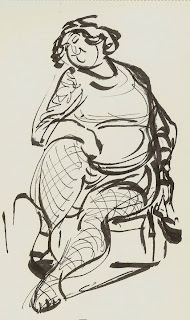

I added simple "orange"graphs to show the overlap example.
Imply
Pronunciation: \im-ˈplī\


- Function: transitive verb
- Inflected Form(s): im·plied; im·ply·ing
- Etymology: Middle English emplien, from Anglo-French emplier to entangle — more at employ
- Date: 14th century
1 obsolete : enfold, entwine
2 : to involve or indicate by inference, association, or necessary consequence rather than by direct statement
3 : to contain potentially
4 : to express indirectly
synonyms see suggest
usage see infer
One of the things that I'm always trying to get across to friends and students is to "Imply" shapes behind other shapes. Walt used to draw a circle over a circle and call it an orange in front of an orange to describe overlap. The drawn lines of the oranges behind the front one where inferred to exemplify body shapes or tree shapes or whatever it was behind what we drew. The other was the mountain example which was pretty self explanatory. I'll use the orange example for the post.


When you look at the definition of "Imply" it starts with obsolete meaning no longer in use or no longer useful. This could help, by thinking we don't need to draw what we can't see the hidden shapes within the overlap. The second definition is about inferring and not drawing too direct. To infer the shapes behind others. The third we are containing the shapes behind others and the fourth is indirect expression of the shapes. HA! it all relates when you think about overlap and how we can draw the orange behind the orange!
I had to put the examples first, blogger was acting up!


